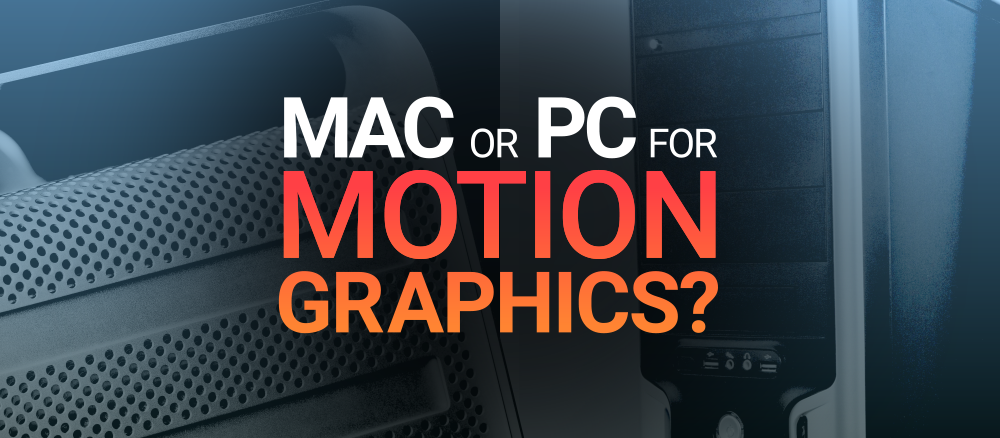
Our team is engaged in a discussion about whether we should all standardize to Windows PCs for our motion and 3D work. I currently work on a Mac, while several of my colleagues are Windows users. In the design department overall, we’re evenly split on both platforms, more from habit than anything else. My first home computer about 25 years ago was a beige box Macintosh IIsi, which I adored. I eventually left Apple once Windows 95 became the de-facto standard. I started with an IBM Aptiva, then had a couple of HP machines, but I was back on a Mac with a G4 tower during freshman year. It’s been Macs ever since both at home and at work for me.
The shift to PC has come primarily from a larger share of our work requiring 3D rendering, which requires a whole different level video card. PC users have a much more extensive selection of compatible cards to choose from than Mac users. At the same time, third-party render engines which require specific video hardware are increasingly popular to extend the built-in capabilities of Cinema 4D. The list of cards that run natively on a Mac and optimized for 3D work is comparatively small. So, where do I stand on this debate? To be honest, I’m not sure. I offer some of my thoughts in this post, though from a decidedly non-technical background. Your mileage may vary!
We have several team members who work remotely, so the traditional infrastructure used in our motion production environment isn’t practical. As a father of an almost-2-year-old, being able to take my work home on my MacBook Pro is incredibly valuable, even if the render speeds aren’t fast. So, I’ve made peace with the tradeoff; you can’t pack as much high-performance computing into a laptop as you can with a desktop. It’s safe to say this rule applies across the platform spectrum. In summary, the performance gains aren’t as compelling when we’re talking about switching from a Mac laptop to a PC laptop.
Several people come to mind when I think of motion designers confronted with the switch from Mac to PC. The first, EJ Hassenfratz, a very talented motion artist and 3D animator, is famously stubborn with his devotion to Mac. He’s managed to set up a pretty solid work station using an eGPU that fulfills his needs. Using this method, you can combine the best of PC video hardware with your preferred operating system and computer. It’s nice to know not everyone at the top of the pro-level needs to switch to PC. And this article by Andy Needham of School of Motion is also helpful for those interested in the eGPU route.
On the other hand, Nick Campbell, a.k.a. Greyscalegorilla, was highly reluctant to switch to PC as more of his work entailed 3D, but eventually took the leap with some help from his PC friends. Getting advice from experts can relieve some of the burdens of selecting an ideal hardware configuration. If Nick can do it, surely, I can! He put together a great post that details the process, including building and pricing out a custom-built PC from AVA Direct, and the anxiety of a Mac user switching to Windows.
The good news is that most of the applications themselves look and feel identical on both Mac and PC nowadays, especially our workhorses in the Adobe Creative Suite. You may need extra time to train your muscle memory to hit the control key instead of command, but it’s otherwise the same. We seamlessly transfer project files between the two platforms regularly. The only time I’m aware someone is working on a particular platform is when I’m standing next to their computer.
It’s clear that in a faceoff between two similarly configured Mac and PC computers, the PC will almost always offer more performance bang for the buck. The equation gets more complicated when factoring in other attributes like portability, warranty support, and personal preference. For Mac users who are scared of putting a PC together, there are custom build options from places that will help you along in the process. Puget Systems comes to mind. We’ve recently engaged their services for two new machines.
If you’re still undecided, consider the following to speed up your workflow:
- Cinema 4D’s Team Render server is a surprisingly simple thing to set up. It works in the background, cross-platform and requires no additional hardware besides a network connection. Distributing the workload of rendering across several machines can help with speed, and we’ve used it in our office with promising results.
- You can gain speed by tweaking render settings in your projects. For example, Lowering the settings on anti-aliasing and depth of reflections and shadows even slightly can make a big difference. YouTube has all sorts of tutorials on this topic along with workload distribution.
- Can you achieve your project goals in a different style by modifying how you’re approaching your 3D? Photo realism isn’t always necessary, and in many cases a simpler look works even better. I love the cel-shaded, “toon” style, which is a fast render on almost any machine. It’s also available to a much larger group of 3D artists with the release of Cinema 4D R21, which is sold as a single subscription-based offering. All users now have access to the Sketch ‘n Toon module that was previously only available in the most expensive “Studio” flavor.
I like using the Mac because it’s what I know, and I can focus on my design work without fussing with the computer much. The old maxim about Macs “just working” is still mostly true. But, I haven’t used Windows regularly in years, and maybe both platforms “just work” now? On the other hand, the limitless options available to PC users brings complexity and unpredictability. It’s harder to get hardware components, software, and peripherals from a myriad of manufacturers to play nicely together. But more and more designers are taking the plunge, and I may soon have to join them.
Up until very recently, the professional designer, editor, or animator all felt Apple was leaving them behind. With the intense focus on consumer products such as the iPhone and other mobile devices, the Mac Pro has languished for years without a significant update, while stuck at a relatively high purchase price. But finally, our long-unanswered cries were acknowledged at this year’s WWDC, when Apple unveiled a redesigned Mac Pro. To my surprise, the old form factor is making a comeback, albeit with much more significant “cheese grater” holes. Naturally, I liked it, but the still-too-high price is a bit of a barrier for me. For the Mac die-hards out there who can’t fathom switching to Windows, you have an alternative.
There’s one more thing to keep in mind: A fancy new system will not improve the quality of a designer’s work. All the rendering power in the world can still look pretty mediocre if the content is lacking. Computers are just tools, and what you put into them will greatly affect what they spit back out, regardless of how top-of-the-line your video card is!




